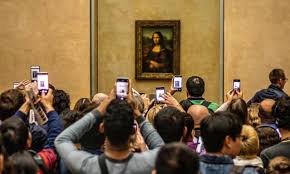In Benjamin’s essay, mechanical reproduction is perceived as a powerful agent that arouses through the birth of photography and film as brands of technology. The latter manages to change the role of art by detaching it from its aura, authenticity, and tradition . These three aspects that feature an artistic work represents its quality and feeling which can be grasped only by being an eye-witness of its here-and-now, and which are deconstructed by means of the replication and manipulation of mechanical reproduction.
Benjamin discusses the transition which an artistic work undergoes by means of replication which moves an artwork from the notion of cult value to the notion of exhibition value. An artistic work is no longer reserved from the eyes of its audience; the latter easily access to art through some of the most powerful agents of technology: TV screens, smart phones, computers, and other gadgets. These devices pull art from a tiny show room and push it to a universal stage; they change it from an object of reservation and concentration with a limited access from its audience to an object of advertisement and distraction with an unlimited access from its audience. Furthermore, mechanical reproduction manages to connect art with politics. Aesthetics which stands for the sublimity of art is attached to some of the political events, particularly war. The latter, through the lenses of the camera, is portrayed as an artistic work that no longer brings terror to the hearts of its audience, but it only fills them with joy and thriller.



